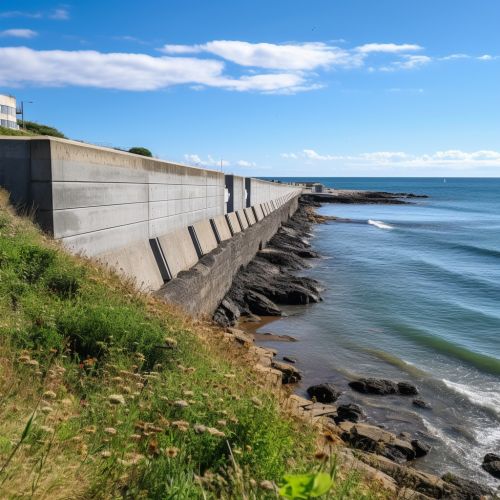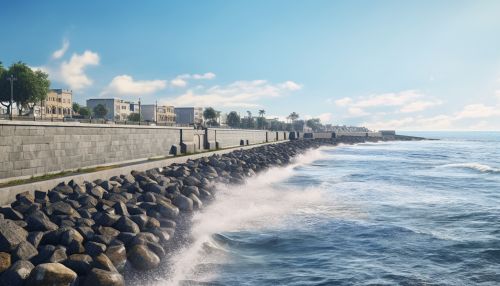Sea wall
Introduction
A sea wall is a form of coastal defense constructed where the sea, and associated coastal processes, impact directly upon the landforms of the coast. The purpose of a sea wall is to protect areas of human habitation, conservation and leisure activities from the action of tides, waves, or tsunamis. As a coastal engineering measure, sea walls are one of the most basic means to mitigate the effects of coastal erosion.


Design and Construction
Sea walls are designed to withstand the forces of wave action and flooding associated with storms and cyclones. The materials used for construction are chosen based on their ability to withstand these forces, and the local availability of materials. Common materials used in the construction of sea walls include concrete, stone, steel, and timber. The design of a sea wall will depend on the specific requirements of the location, including the nature of the waves and tides, the slope of the land, and the type of soil or rock on which the wall is to be built.
The construction of a sea wall involves several steps. First, a detailed survey of the site is conducted to determine the exact location and dimensions of the wall. This includes an assessment of the wave and tide conditions, the soil or rock conditions, and any existing structures or natural features that may affect the construction. Once the design is finalized, the construction process begins with the excavation of the site and the preparation of the foundation. The wall is then built up in layers, with each layer carefully compacted and reinforced as necessary. The final step is the placement of the facing material, which provides the final protective barrier against the sea.
Types of Sea Walls
There are several types of sea walls, each with their own specific design characteristics and uses. These include:
- Vertical Walls: These are the simplest form of sea wall, consisting of a vertical barrier that reflects wave energy back into the sea. They are typically constructed of concrete or stone, and are often used in urban areas where space is limited.
- Curved or Stepped Walls: These are designed to dissipate wave energy by causing the waves to break upon the steps or the curved surface of the wall. This reduces the impact of the waves on the wall and the surrounding area.
- Revetments: These are sloping structures, often built of loose stone or concrete blocks, that absorb wave energy rather than reflecting it. They are typically used in areas of high wave energy, where a vertical or curved wall would be subject to significant erosion.
- Bulkheads: These are similar to vertical walls, but are typically used in calmer waters, such as estuaries or harbors. They are often used to retain land rather than to protect against wave action.
Environmental Impact
While sea walls are effective at protecting coastal areas from erosion and flooding, they can also have significant environmental impacts. These include changes to the natural coastal processes, loss of beach area, and impacts on marine life.
Sea walls can disrupt the natural movement of sand along the coast, leading to increased erosion in areas not protected by the wall. This can result in the loss of beach area, which can have impacts on both human use of the beach and on coastal ecosystems.
The construction and presence of sea walls can also have direct impacts on marine life. The construction process can disturb habitats and displace species, while the wall itself can create a physical barrier that prevents the movement of species along the coast.
Maintenance and Management
The maintenance of sea walls is a critical aspect of their effectiveness. Regular inspections are necessary to identify any damage or deterioration, and repairs should be carried out promptly to prevent further damage. The management of sea walls also involves monitoring the surrounding coastal processes and adjusting the design or operation of the wall as necessary to respond to changes in these processes.
